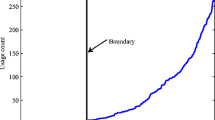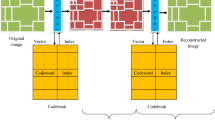Abstract
An extremely difficult problem in an image compression method is increasing the compression ratio while maintaining the visual quality of the image. One of the popular imae compression strategies that can be found in literature is vector quantization. The size of the Codebook and Index matrix created as a result of this procedure determines how effective it is. The Codebook has a size of nc*cwd, where cwd is the codeword dimension and nc is the number of clusters. These n number of codewords do not all have an equal impact on the visual quality of the decompressed image. Some of these are essential for rebuilding the decompressed image, while others are less significant. In this paper, a novel strategy is put forth to divide a codebook's nc number of codewords into two groups. The codewords used most frequently in reconstructing the image are in one section, while the rest are included in the second group of less crucial codewords. The first group’s codewords are left in tact to preserve the decompressed image’s visual quality, but the second group’s codewords are quantized into two bit values, namely 0, 1, 2, and 3, to increase compression ratio. The suggested technique is used on numerous colour images from the UCIDv.2 database as well as images from the standard image database. Peak signal to noise ratio, structural similarity ındex measure and Compression Ratio are used to analyse the experimental outcomes. Depending on the size of the original image, experimental results reveal that the suggested method reduces the codebook size by 32.01–54.80% while maintaining the quality of the decompressed image. This greatly improves the compression ratio of the algorithm.















Similar content being viewed by others
Data availability
Not Applicable.
Code availability
Not Applicable.
References
Avcibas, I., Memon, N., & Sayood, K. (2002). A progressive lossless/near lossless image compression algorithm. IEEE Signal Processing Letters, 9(10), 312–314.
Barman, D., Hasnat, A., Sarkar, S., & Rahaman, M. A. (2016). Color image quantization using gaussian particle swarm optimization (CIQ-GPSO). In IEEE international conference on inventive computation technologies. https://doi.org/10.1109/INVENTIVE.2016.7823295
Barman, D., Hasnat, A., & Barman, B. (2022b) An enhanced technique to improve the performance of multi-image compression technique. In R. N. Shaw, S. Das, V. Piuri, & M. Bianchini (Eds.), Advanced computing and intelligent technologies. Lecture Notes in Electrical Engineering (vol. 914). Springer. https://doi.org/10.1007/978-981-19-2980-9_25
Barman, D., Hasnat, A., & Barman, B. (2020a) A codebook modification method of vector quantization to enhance compression ratio. In C. Satyanarayana, D. Samanta, X. Z. Gao, R.K. Kapoor (Eds.), High performance computing and networking. lecture notes in electrical engineering (vol. 853, pp. 227–234). Springer. https://doi.org/10.1007/978-981-16-9885-9_19
Bing, Z., Junyi, S., & Qinke, P. (2004). An adjustable algorithm for color quantization. Pattern Recognition Letters, 25(16), 1787–1797. https://doi.org/10.1016/j.patrec.2004.07.005
Celebi, M. E, Wen, Q., & Chen, J. (2011). Color quantization using C-means clustering algorithms. In proceedings of the18th IEEE international conference on image processing (pp. 1729–1732). https://doi.org/10.1109/ICIP.2011.6115792
Chang, H., Ng, M. K., & Zeng, T. (2013). Reducing artifacts in JPEG decompression via a learned dictionary. IEEE Transactions on Signal Processing, 62(3), 718–728. https://doi.org/10.1109/TSP.2013.2290508
Charrier, C., Knoblauch, K., Maloney, L. T., Bovik, A. C., & Moorthy, A. K. (2012). Optimizing multiscale SSIM for compression via mlds. IEEE Transactions on Image Processing, 21(12), 4682–4694. https://doi.org/10.1109/TIP.2012.2210723
Cheng, S. C., & Yang, C. K. (2001). A Fast and novel technique for color quantization using reduction of color space dimensionality. Pattern Recognition Letters, 22(8), 845–856. https://doi.org/10.1016/S0167-8655(01)00025-3
Chiranjeevi, K., & Jana, U. N. (2016). Fast vector quantization using a bat algorithm for image compression. Engineering Science and Technology an International Journal, 19(2), 769–781. https://doi.org/10.1016/j.jestch.2015.11.003
Chiranjeevi, K., & Jana, U. N. (2018). Image compression based on vector quantization using cuckoo search optimization technique. Ain Shams Engineering Journal, 9(4), 1417–1431. https://doi.org/10.1016/j.asej.2016.09.009
Gan, G., Ma, C., & Wu, J. (2007). Data clustering theory, algorithms and applications. SIAM.
Gonzalez, R. C., Woods, R. E., & Eddins, S. L. (2011). Digital image processing using MATLB. Mc-Graw Hill.
Hasnat, A., & Barman, D. (2019). A proposed multi-image compression technique. Journal of Intelligent & Fuzzy Systems, 36(4), 3177–3193. https://doi.org/10.3233/JIFS-18360
Hasnat, A., Barman, D., & Barman, B. (2021). Luminance approximated vector quantization algorithm to retain better image quality of the decompressed image. Multimedia Tools and Applications, 80, 11985–12007. https://doi.org/10.1007/s11042-020-10403-9
Hasnat, A., Barman, D., Halder, S., & Bhattacharjee, D. (2017). Modified vector quantization algorithm to overcome the blocking artefact problem of vector quantization algorithm. Journal of Intelligent & Fuzzy Systems, 32(5), 3711–3727. https://doi.org/10.3233/JIFS-169304
Hurtik, P., & Perfilieva, I. (2017). A hybrid image compression algorithm based on JPEG and Fuzzy transform. In IEEE international conference on fuzzy systems (pp. 1–6). https://doi.org/10.1109/FUZZ-IEEE.2017.8015614
Jain, A. K., & Dubes, R. C. (2004). Algorithms for clustering data. Prentice-Hall.
Kil, D. H., & Shin F. B. (1995). Reduced dimension image compression and its applications. In proceedings of the international conference image processing (vol. 3, pp. 500–503).
Leitao, H. A. S., Lopes, W. T. A., & Madeiro, F. (2015). PSO algorithm applied to codebook design for channel-optimized vector quantization. IEEE Latin America Transactions, 13(4), 961–967. https://doi.org/10.1109/TLA.2015.7106343
Li, C. K., & Yuen, H. (1996). A High-performance image compression technique for multimedia applications. IEEE Transactions on Consumer Electronics, 42(2), 239–243.
Liao, X., Qin, Z., & Ding, L. (2017). Data embedding in digital images using critical functions. Signal Processing: Image Communication, 58, 146–156. https://doi.org/10.1016/j.image.2017.07.006
Liao, X., Yu, Y., Li, B., Li, Z., & Qin, Z. (2020). A new payload partition strategy in color image steganography. IEEE Transactions on Circuits and Systems for Video Technology, 30(3), 685–696. https://doi.org/10.1109/TCSVT.2019.2896270
Linde, Y., Buzo, A., & Gray, R. M. (1980). An algorithm for vector quantizer design. IEEE Transactions on Communications COM, 28(1), 84–195.
Mahapatra, D. K., & Jena, U. R. (2013). Partitional K-means clustering based hybrid DCT-vector quantization for image compression. In IEEE conference on ICT. Noorul Islam University Thuckalay. https://doi.org/10.1109/CICT.2013.6558278
Mandal, J. K. (2020). Reversible steganography and authentication via transform encoding. ISBN: 9789811543975, Springer.
Oztana, B., Malikb, A., Fanb, Z., & Eschbachb, R. (2007). Removal of artifacts from JPEG compressed document images. In Proceedings of SPIE-IS&T electronic imaging, (vol. 6493, pp. 649306-1). https://doi.org/10.1117/12.705414
Ozturk, C., Hancer, E., & Karaboga, D. (2014). Color image quantization: A short review and an application with artificial bee colony algorithm. Journal Informatica, 25(3), 485–503.
Prasetyo, H., Wiranto & Winarno. (2018). Suppressing JPEG artifact using dot-diffused DC components modification. In IEEE international conference on automation, cognitive science, optics, micro electromechanical system and information technology. https://doi.org/10.1109/ICACOMIT.2017.8253383
Saad, M. A., Bovik, A. C., & Charrier, C. (2012). Blind image quality assessment: A natural scene statistics approach in the dct domain. IEEE Transactions on Image Processing, 21(8), 3339–3352. https://doi.org/10.1109/TIP.2012.2191563
Sara, U., Akter, M., & Uddin, M. S. (2019). Image quality assessment through FSIM, SSIM, MSE and PSNR: A comparative study. Journal of Computer and Communications, 7(3), 8–18. https://doi.org/10.4236/jcc.2019.73002
Scheunders, P. (1997). A genetic C-means clustering algorithm applied to color image quantization. Pattern Recognition, 30(6), 859–866. https://doi.org/10.1016/S0031-3203(96)00131-8
Shah, P. K., Pandey, R.P., & Kumar, R. (2016) Vector quantization with codebook and index compression. In IEEE international conference system modeling & advancement in research trends. https://doi.org/10.1109/SYSMART.2016.7894488
Thepade, S. D., Mhaske, V., & Kurhade, V. (2013) New clustering algorithm for vector quantization using slant transform. ICETACS, St. Anthony's College. https://doi.org/10.1109/ICETACS.2013.6691415
Wang, J., & Zhu, E. (2015). A new method of reducing boundary artifacts for JPEG2000 multi-tile coding. In IEEE international conference on imaging systems and techniques (IST). https://doi.org/10.1109/IST.2015.7294570
Wu, M. T. (2015). Efficient reduction of artifact effect based on power and entropy measures. In IEEE international conference on fuzzy system and knowledge discovery (FSKD). https://doi.org/10.1109/FSKD.2015.7382241
Funding
This research receives no specific grant from any funding agency in the public, commercial or not-for-profit sector.
Author information
Authors and Affiliations
Contributions
Not Applicable.
Corresponding author
Ethics declarations
Conflict of interest
The Authors declare that there is no conflict of interest.
Consent to participate
Not Applicable.
Consent for publication
Not Applicable.
Ethical approval
Not Applicable.
Human and animal rights
Not Applicable.
Additional information
Publisher's Note
Springer Nature remains neutral with regard to jurisdictional claims in published maps and institutional affiliations.
Rights and permissions
Springer Nature or its licensor (e.g. a society or other partner) holds exclusive rights to this article under a publishing agreement with the author(s) or other rightsholder(s); author self-archiving of the accepted manuscript version of this article is solely governed by the terms of such publishing agreement and applicable law.
About this article
Cite this article
Barman, D., Hasnat, A. & Barman, B. A quantization based codebook formation method of vector quantization algorithm to improve the compression ratio while preserving the visual quality of the decompressed image. Multidim Syst Sign Process 34, 127–145 (2023). https://doi.org/10.1007/s11045-022-00856-6
Received:
Revised:
Accepted:
Published:
Issue Date:
DOI: https://doi.org/10.1007/s11045-022-00856-6




